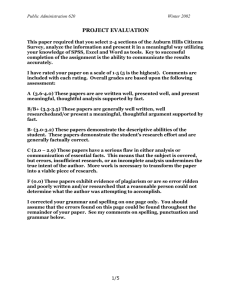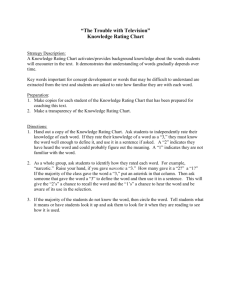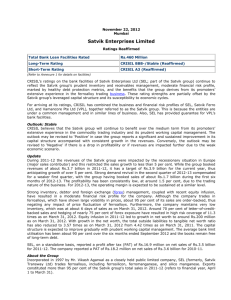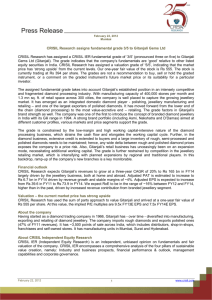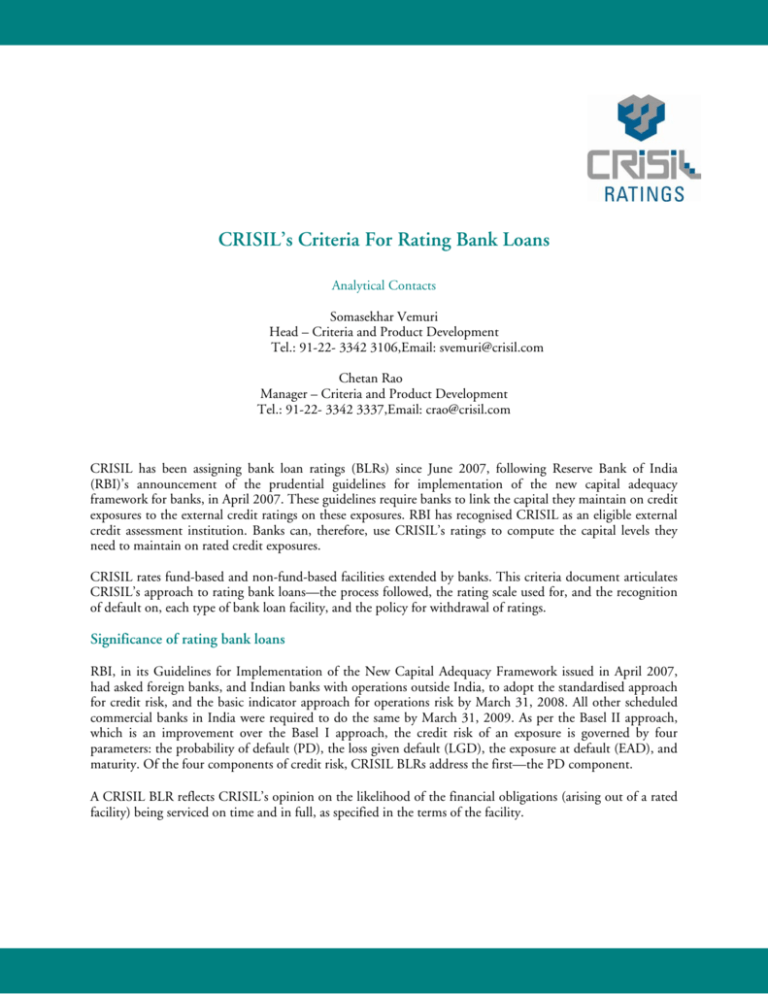
CRISIL’s Criteria For Rating Bank Loans
Analytical Contacts
Somasekhar Vemuri
Head – Criteria and Product Development
Tel.: 91-22- 3342 3106,Email: svemuri@crisil.com
Chetan Rao
Manager – Criteria and Product Development
Tel.: 91-22- 3342 3337,Email: crao@crisil.com
CRISIL has been assigning bank loan ratings (BLRs) since June 2007, following Reserve Bank of India
(RBI)’s announcement of the prudential guidelines for implementation of the new capital adequacy
framework for banks, in April 2007. These guidelines require banks to link the capital they maintain on credit
exposures to the external credit ratings on these exposures. RBI has recognised CRISIL as an eligible external
credit assessment institution. Banks can, therefore, use CRISIL’s ratings to compute the capital levels they
need to maintain on rated credit exposures.
CRISIL rates fund-based and non-fund-based facilities extended by banks. This criteria document articulates
CRISIL’s approach to rating bank loans—the process followed, the rating scale used for, and the recognition
of default on, each type of bank loan facility, and the policy for withdrawal of ratings.
Significance of rating bank loans
RBI, in its Guidelines for Implementation of the New Capital Adequacy Framework issued in April 2007,
had asked foreign banks, and Indian banks with operations outside India, to adopt the standardised approach
for credit risk, and the basic indicator approach for operations risk by March 31, 2008. All other scheduled
commercial banks in India were required to do the same by March 31, 2009. As per the Basel II approach,
which is an improvement over the Basel I approach, the credit risk of an exposure is governed by four
parameters: the probability of default (PD), the loss given default (LGD), the exposure at default (EAD), and
maturity. Of the four components of credit risk, CRISIL BLRs address the first—the PD component.
A CRISIL BLR reflects CRISIL’s opinion on the likelihood of the financial obligations (arising out of a rated
facility) being serviced on time and in full, as specified in the terms of the facility.
CRISIL’s process for BLRs
The process that CRISIL follows (refer to Chart 1) in rating bank loans is similar to the process it follows in
rating capital market debt instruments such as bonds, debentures and commercial paper. Chart 1 illustrates
CRISIL’s rating process for BLRs.
Chart 1: Process flow for a rating assignment
Issuer
CRISIL
Requests
for rating
Signs rating
agreement
Provides
information and
rating fees
Rating team assigned. Team
collates information, conducts
preliminary analysis.
Management
meetings with
the rating team
Team performs credit analysis
Analysis presented to
Rating Committee
Accepts the
rating.
Or Appeal
Rating assigned and
communicated to issuer
Rating disseminated and
communicated to issuer.
All ratings kept under continuous
Surveillance throughout validity
The impact of security on CRISIL BLRs
CRISIL’s ratings address PD, one of the four components of credit risk, as identified under the Basel II
approach. Since lenders normally enforce their security interests only after default has occurred, realisations
from assets do not influence probability of default. For instance, for availing letter of credit (LC) facility,
companies may offer 10-20 per cent of the facility limit as cash margins to the bank. However, this cash
margin does not help the bank in preventing a company from default. Hence, CRISIL will not provide any
uplift to the facility rating on account of these cash margins. Nevertheless, asset security does have a
significant impact on the LGD component of credit risk under the Basel II approach.
The presence of liquid assets on a company’s balance sheet does, however, add to its financial flexibility.
CRISIL factors this additional financial flexibility into all its BLRs.
CRISIL’s rating scales for BLRs
CRISIL assigns BLRs on the same scales as those it uses in assigning ratings to capital market debt
instruments, including bonds, debentures, and commercial paper (refer Annexure 1).
Long-term vs short-term rating scale
The scale used in assigning a rating to a term loan depends on the loan’s original maturity as specified in the
terms of the facility. This is in line with CRISIL’s approach for assigning ratings to debentures. Also, RBI
guidelines specify that a bank facility’s maturity is the original contracted maturity, and not residual maturity.
Therefore, a term loan with an original contracted maturity of 7 years, for instance, will be rated on the longterm scale, even if the residual maturity is only 8 months.
Some fund-based facilities such as cash credit and working capital demand loans (WCDLs) are sanctioned for
a period of one year; however, these facilities are often rolled over, and, hence, are akin to long-term exposures
from the bank’s perspective. CRISIL, therefore, usually assigns ratings to these facilities on the long-term
scale. In fact, RBI’s guidelines specify that banks use the long-term ratings to compute capital requirement on
such exposures. Other fund-based facilities such as packing credit, post-shipment credit, and bill discounting
have maturity of less than a year, and are, therefore, rated on the short-term scale.
CRISIL assigns ratings to non-fund based facilities such as letters of credit or bank guarantees usually on the
short-term scale. When a bank guarantee is invoked, or a letter of credit devolves on the borrower, the bank
makes a payment to the third party on behalf of the borrower. The borrower is required to make good this
payment to the bank as per the terms of the bank guarantee facility within a short timeframe. Since the period
available for the borrower for repayment is short, these facilities are rated on a short-term scale.
Table 1 lists the rating scales that CRISIL follows in rating bank loan facilities.
Table 1: Types of Credit Facilities and Rating Scale Applicable
Fund-based facilities
Packing credit
Cash credit
Working capital demand loan (WCDL)
Purchase bill discounting
Bill purchase/discounting
Factoring/Forfeiting
Post-shipment credit
Short-term loan
Foreign-currency non-resident loan
Term loans
External commercial borrowings (ECBs)
Mortgage loan facility
Vendor financing
Non-fund-based facilities
Bank guarantee
Letter of credit
* Based on tenure of loan
Rating scale
Short–term
Long–term
Long–term
Short–term
Short–term
Short–term
Short–term
Short–term
Long–term /Short–term *
Long–term
Long-term
Long-term
Short-term
Rating scale
Short–term
Short–term
Banks often sanction credit limits to borrowers, and allow them the flexibility to draw down the limits as one
of several pre-determined facilities—in other words, these facilities are fungible between those usually rated on
the long-term scale (referred to as a long-term facility) and those rated on the short-term scale (referred to as a
short-term facility). In such instances, the portion of the facility that can be drawn down as a long-term
facility is assigned a rating on the long-term scale, while the remaining portion is assigned a rating on the
short-term scale. CRISIL’s approach is in line with RBI’s clarification on this issue.
Recognition of default on bank loan facilities
CRISIL assigns ratings to bank loans as per the terms of the facility, with respect to both repayment amount
and repayment date. Consequently, any failure to honour debt obligations as per the terms of the facility are
construed as default on the rated facility; this is distinct from the banking norms, where an account is
recognised as a non-performing asset (NPA) only when it remains unpaid for more than 90 days after the due
date. All facilities in default will carry a rating of ‘D’ on the long-term scale, or ‘P5’ on the short-term scale.
The rating will remain in the default category until the arrears are cleared, and a track record of timely
repayment is established subsequently.
For term loans, failure to repay the amounts in full on due date is construed as default on the rated facility.
Some bank facilities such as cash credit, which do not have specific due dates for repayment, allow borrowers to
overdraw on the facility for a specified period with permission from the bank. Though such overdrawing may
not necessarily indicate weakening in the borrower’s credit quality, banks believe that facilities overdrawn for
more than 30 days indicate deteriorating credit quality, and may classify such exposures as potential NPAs. As a
result, CRISIL deems cash credit facilities to be in default if they continue to remain overdrawn for more than
30 consecutive days. Similar terms apply for some non-fund based facilities such as bank guarantees. Typically,
banks classify non-fund based facilities which remain overdue beyond 30 days as potential NPAs. CRISIL
deems these facilities to be in default if the devolved amount remains unpaid for more than 30 days. CRISIL
also follows a similar approach to recognition of default for other working capital facilities like packing credit,
bill discounting etc.
Treatment of restructuring and rescheduling
CRISIL expects entities that have requested restructuring or rescheduling of their debt obligations will
continue to meet interest payment and principal repayment obligations on time and in full as per the existing
debt repayment schedule, until the lenders formally approve such requests. If borrowers fail to meet debt
service obligations on time and in full pending approval of the request, CRISIL will treat such failure as
default on the rated facilities.
Upon receiving formal lender consent to the restructured terms, CRISIL will use the revised repayment
schedule in its future analysis and recognition of default.
Withdrawal of ratings
CRISIL’s BLRs are not one-time exercises and are under continuous surveillance over the life of the rated
facility. CRISIL’s policy for withdrawal of ratings stipulates that ratings on facilities (such as term loans),
which have scheduled repayment dates, may be withdrawn only on redemption/maturity of the rated
facilities. The ratings may also be withdrawn if the rated facilities are pre-paid by the borrower, with the
lender’s consent, before maturity. For facilities such as cash credit, which do not have a scheduled repayment
date, the rating is placed on notice for withdrawal for one year, and subsequently withdrawn. CRISIL does
not withdraw ratings immediately on request by borrowers; this is because the end users of the ratings (banks)
may face sudden changes in prudential capital requirements when rated facilities suddenly go to an unrated
state.
Annexure 1: CRISIL rating scales
Long-term rating scale
AAA
AA
A
BBB
BB
B
C
D
NM
•
•
•
•
Short-term rating scale
P1
P2
P3
P4
P5
NM
CRISIL may apply '+' (plus) or '-' (minus) signs to ratings from 'AA' to 'C' to reflect comparative
standing within the category; CRISIL may apply ‘+’ (plus) sign to ratings from 'P1' to 'P4' to reflect a
comparatively higher standing within the category.
CRISIL may assign rating outlooks to ratings from 'AAA' to 'B'. Ratings on Rating Watch will not carry
outlooks. A rating outlook indicates the direction in which a rating may move over a medium-term
horizon of one or two years. A rating outlook may be 'Positive', 'Stable', or 'Negative'. A 'Positive' or
'Negative' rating outlook is not necessarily a precursor of a rating change.
The suffix '(so)' indicates instruments with structured obligation. CRISIL’s rating on structured
obligations reflects CRISIL's opinion on the degree of credit protection provided by the credit
enhancement structure. The assessment takes into consideration arrangements for payment on the
instrument by an entity other than the issuer to fulfil the financial obligations on the instrument. It also
takes into account other means of enhancing the credit quality of the rated obligation.
The suffix 'r' indicates investments carrying non-credit risk. The 'r' suffix indicates that payments on the
rated instrument have significant risks other than credit risk. The terms of the instrument specify that
payments to investors will not be fixed, and may be linked to one or more external variables such as
commodity prices, equity indices, or foreign exchange rates. This may result in variability in payments—
including possible material loss of principal—because of adverse movement in the values of external
variables. The risk of such adverse movement in price/value is not addressed by the rating.
Disclaimer
CRISIL has taken due care and caution in preparing this report. Information has been obtained by CRISIL from sources which it
considers reliable. However, CRISIL does not guarantee the accuracy, adequacy or completeness of any information and is not
responsible for any errors in transmission and especially states that it has no financial liability whatsoever to the subscribers/ users/
transmitters/ distributors of this report. No part of this report may be reproduced in any form or any means without permission of the
publisher. Contents may be used by news media with due credit to CRISIL.
©
CRISIL. All Rights Reserved.
Head Office:
CRISIL House,Central Avenue Road, Hiranandani Business Park,Powai, Mumbai - 400 076
Tel: +91-22- 3342 3000 Fax: +91-22- 3342 3001 www.crisil.com




